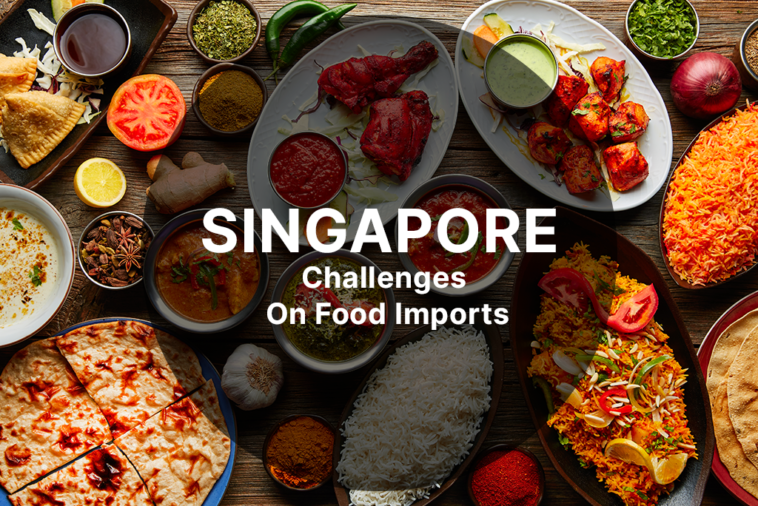Singapore, known for its vibrant and mountainous street food market, is now facing challenges in obtaining food. The limited natural resources in Singapore are the primary reason behind it. However, more factors pushed the food imports in Singapore to become challenging to do.
There is first the ban on chicken exports from Malaysia. Then there is a rising inflation rate on a global scale. Last but not least, the increasing food insecurity after the Russian invasion of Ukraine… All these factors have played the role in bringing challenges to food imports in Singapore.
Singapore’s Reliance On Food Imports
Singapore is a small country on an island with land scarcity to grow its own food. In the scarcity of land and hence natural resources, Singapore relies heavily on food imports from other countries. As per Singapore Food Agency, it imports about 90% of its food consumed.
We have collected the group of processed food and agricultural products that Singapore imports. The following represented import data of Singapore shows the top imports for 2021. Singapore’s reliance on imported foods and agricultural products can be seen in the table below.

To further segregate the above-shown data, the table below shows the top food imports of Singapore. While the above table featured both food and beverage, along with agricultural imports, the below represented Singapore import data 2021 features only essential foods.

Challenges Singapore Faces In Importing Food
Singapore’s reliance on food imports brings natural challenges along the way for Singapore. This consists of export bans imposed by other countries on food commodities. The recent ban on chicken exports from Malaysia caused a stir in Singapore.
Read More: Malaysia Chicken Export Ban, Secures Its Own Domestic Supplies
Singapore imported $159.7 million worth of chickens from Malaysia in 2021. Malaysia accounts for about one-third of Singapore’s total live chicken/fowl exports. Edible fowl meat is also another option for Singapore vendors to sell and consumers to savour. Below is the shown list of countries that import edible chicken meat to Singapore, as per Singapore import data 2021.

As evident from the shown data, Singapore is dependent on fowl meat imports from Brazil. Brazil accounts for about eighty per cent of its total meat exports, fulfilling the third-fourth of consumer demand. Other countries in the list account for exports lower than 10%.
Since COVID-19, the Singapore authorities worked towards the normalization of food security in the island nation. COVID-19 is the biggest factor and the origin of the issue of food security, especially in Singapore. The next wave of COVID-19 also brings speculation on this state.
Read More: How Russia-Ukraine War and China’s COVID Spike Will Disrupt Global Supply Chains?
Facing the disruptions of imports due to COVID-19 throughout the year 2020, 2021 was the time when countries had to rebound. Lifted restrictions and lockdown measures in 2021 fastened the process of rebounding the global economy and bringing food security levels to a normal level.
However, at the beginning of the year 2022, the global economy again felt hit by inflation. The global inflation rate spiked the prices of essential commodities such as fuel and food. The USA and the UK face a 40-year-high inflation rate, which is concerning many countries.
Read More: The Highest UK Inflation In 40 Years, Living Cost Soaring High
In facing the challenges of food imports in Singapore, there are not only economic factors but also political factors that play a role. The Russian invasion of Ukraine brought a heavy amount of global food insecurity, curtailed by the supply chain disruptions from both countries.
Singapore faced rising inflation around food commodities during the pandemic in 2020. The Russia-Ukraine war only pushed the rising cost of commodities to another height. The cost of essential food commodities such as cooking oil, meat, and eggs has increased by 30%-45%.
Read More: G7 Countries Not To Limit Their Food Exports, Says Ministers
Abolition of Singapore’s Reliance On Food Imports
Both the Monetary Authority of Singapore and the Ministry of Trade and Industry shared the official figures. The authorities shared that food prices in Singapore increased by 4.1% in April from the previous year. This has also led to slacking down of imports from businesses.
Fortunately, the authorities in Singapore are working towards abolishing the challenges. In the initiative of “30 by 30”, as quoted by Singapore Food Agency, “Singapore aims to produce 30% of its nutritional needs by 2030”. This is an initiative that allows Singapore to be self-reliant.
However, it will not be false to say that Singapore has limited natural resources and has to rely on technological advancements then. Building alternative supply chains from other countries can also be a way Singapore can safeguard its domestic food supply and consumer demand.
The below chart shows the top import markets for Singapore in order to import food commodities. Representation of Singapore import data 2021 is related to the one shown above, titled—“Singapore Top Food & Agro-Based Product Imports”.

As seen in the above data showing the top importing countries for Singapore, the neighbouring country to Singapore, Malaysia accounts for the largest imports. There are no traces of African or Middle-East countries in these top 10 countries. Perhaps, Singapore can build bilateral relations with these countries and generate alternative sources to import food commodities.
Making bilateral and economic relations with other countries is perhaps a long-term solution for Singapore. Singapore being a technologically advanced country can help other countries to improve their farming techniques, as well as build their own units to grow food overseas.




